Southern Europe
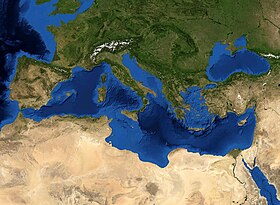
Southern Europe is the southern region of Europe.[1] It is also known as Mediterranean Europe, as its geography is marked by the Mediterranean Sea. Definitions of southern Europe include some or all of these countries and regions: Albania, Andorra, Bosnia and Herzegovina, Bulgaria,[note 1] Croatia, Cyprus,[note 2] Gibraltar,[note 3] Greece,[note 4] Italy,[note 5] Malta,[note 6] Monaco,[note 7] Montenegro, North Macedonia, Portugal, San Marino, Serbia, Slovenia, southern France,[note 8] Spain, Turkey (East Thrace),[note 9] and Vatican City.[4][5][6][7][8][9][10][11]
Southern Europe is focused on the three peninsulas located in the extreme south of the European continent. These are the Iberian Peninsula, the Apennine Peninsula, and the Balkan Peninsula.[12][13] These three peninsulas are separated from the rest of Europe by towering mountain ranges, respectively by the Pyrenees, the Alps and the Balkan Mountains. The location of these peninsulas in the heart of the Mediterranean Sea, as well as their mountainous reliefs, provide them with very different types of climates (mainly subtropical Mediterranean) from the rest of the continent. So, the Sirocco hot wind that originates in the heart of the Sahara blows over Italy, going up to the interior of the Alpine arc (Po Valley). The Alps prevent the Sirocco from spreading to the rest of Europe. And, conversely, the Alps and the Pyrenees protect the Italian and Iberian Peninsulas from the rains and icy winds from the south of France such as the Mistral and the Tramontane. When the Mistral and the Tramontane are blowing, this provokes an "upwelling" phenomenon on the French coast. They push the surface waters out to sea and bring deeper, cooler waters up to the seaside. Consequently, the temperature of the waters of the French coasts are therefore very cool even in summer, and not representative of the rest of the Mediterranean.[14][15][16] This same kind of phenomenon takes place between the two slopes of the Balkan mountain range. These mountains have, moreover, been a serious handicap to population displacement, focusing southern Europe mainly on the Mediterranean world. The climate and cultures are therefore very specific.
Different methods can be used to define southern Europe, including its political, economic, historical, and cultural attributes. Southern Europe can also be defined by its natural features — its geography, climate, and flora. Politically, nine of the southern European countries form the EU Med Group. Southern Europe also loosely corresponds to the European part of the Mediterranean Basin.
Geography
[edit]Geographically, southern Europe is the southern portion of the European continent. This definition is relative, although largely based on history, culture, climate, and flora, which is shared across the region. Southern Europe can be subdivided into three subregions:
- Iberian Peninsula and the surrounding islands (Southwest Europe)
- Italian geographic region[note 5] (South-central Europe)
- Southeast Europe
The major islands in southern Europe generally include the Balearic Islands, Corsica, Crete, Cyprus,[note 2] Sardinia, and Sicily, as well as the island country of Malta.[note 6]
Gallery
[edit]-
Map representing the geography of Europe, with the mountain ranges separating southern Europe
-
Satellite image of the Iberian Peninsula
-
Satellite image of the Apennine Peninsula
-
Satellite image of the Balkan Peninsula
Climate
[edit]
Southern Europe's most emblematic climate is the Mediterranean climate, influenced by the large subtropical semi-permanent centre of high atmospheric pressure found, not in the Mediterranean itself, but in the Atlantic Ocean, the Azores High. The Mediterranean climate covers Portugal, Spain, Italy, the southern coast of France, coastal Croatia, coastal Slovenia, southern Bosnia and Herzegovina, Montenegro, Albania, and Greece, as well as the Mediterranean islands. Those areas of Mediterranean climate present similar vegetations and landscapes throughout, including dry hills, small plains, pine forests and olive trees.
Cooler climates can be found in certain parts of southern European countries, for example within the mountain ranges of Spain and Italy. Additionally, the north coast of Spain experiences a wetter Atlantic climate. In the highest regions of the Alps, which border southern Europe, even ice cap climate can be found.[note 16]
Some parts of southern Europe have humid subtropical climates with warm and wet summers, unlike typical Mediterranean climates. This climate is mainly found in Italy and Croatia around the Adriatic Sea in cities such as Venice and Trieste, but also further north, near the Alpine foothills, in cities such as Como and Lugano.
Flora
[edit]
Southern Europe's flora is mainly characterized by Mediterranean forests, woodlands, and scrub, but also temperate broadleaf and mixed forests. The Mediterranean and Submediterranean climate regions in Europe are found in much of southern Europe, mainly Portugal, Spain, Italy, Malta, Albania, Greece, Cyprus and all the mediterranean islands, but also in southeast France, the Balkan Mediterranean coast and part of Macedonia.[19][20]
In the Mediterranean coastal areas, olive groves, maquis shrubland, and steppes are very common. At higher elevations, or latitudes, they are replaced by chestnut and (often coppiced) mixed forests.[21]
-
Beech forest in the Aurunci Mountains, Italy
-
Stone pines in Doñana National Park, Spain
-
Aleppo pine forest, Croatia
-
Temperate pine forests of Monte Cimone, Italy
-
Dry olive groove, Crete
History
[edit]Early history
[edit]
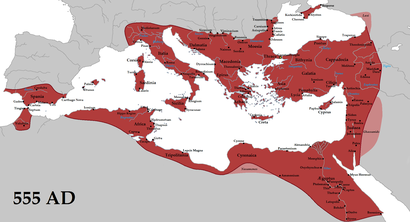
The Phoenicians originally expanded from Canaan ports, dominating trade in the Mediterranean by the 8th century BC. Carthage was founded in 814 BC, and the Carthaginians by 700 BC had firmly established strongholds in Sicily and Sardinia (both regions in present day Italy), which created conflicts of interest with Etruria. Its colonies later reached the Western Mediterranean, such as Cádiz in Spain and most notably Carthage in North Africa, and even the Atlantic Ocean. The civilisation spread across the Mediterranean between 1500 BC and 300 BC.[22]
The period known as classical antiquity began with the rise of the city-states of Ancient Greece. Greek influence reached its zenith under the expansive empire of Alexander the Great, spreading throughout Asia. The Roman Empire came to dominate the entire Mediterranean Basin in a vast empire based on Roman law and Roman legions. It promoted trade, tolerance, and Greek culture. By 300 AD the Roman Empire was divided into the Western Roman Empire based in Rome, and the Eastern Roman Empire based in Constantinople. The attacks of the Goths led to the fall of the Western Roman Empire in 476 AD, a date which traditionally marks the end of the classical period and the start of the Middle Ages. During the Middle Ages, the Eastern Roman Empire survived, though modern historians refer to this state as the Byzantine Empire. In Western Europe, Germanic peoples moved into positions of power in the remnants of the former Western Roman Empire and established kingdoms and empires of their own.
The period known as the Crusades, a series of religiously motivated military expeditions originally intended to bring the Levant back into Christian rule, began. Several Crusader states were founded in the eastern Mediterranean. These were all short-lived. The Crusaders would have a profound impact on many parts of Europe. Their sack of Constantinople in 1204 brought an abrupt end to the Byzantine Empire. Though it would later be re-established, it would never recover its former glory. The Crusaders would establish trade routes that would develop into the Silk Road and open the way for the merchant republics of Genoa and Venice to become major economic powers. The Reconquista, a related movement, worked to reconquer Iberia for Christendom. The late Middle Ages represented a period of upheaval in Europe. The epidemic known as the Black Death and an associated famine caused demographic catastrophe in Europe as the population plummeted. Dynastic struggles and wars of conquest kept many of the states of Europe at war for much of the period. In the Balkans, the Ottoman Empire, a Turkish state originating in Anatolia, encroached steadily on former Byzantine lands, culminating in the fall of Constantinople in 1453.
Post-Middle Ages
[edit]Beginning roughly in the 12th century in Florence, and later spreading through Europe with the development of the printing press, a Renaissance of knowledge challenged traditional doctrines in science and theology, with the Arabic texts and thought[23] bringing about rediscovery of classical Greek and Roman knowledge. The Catholic reconquest of Portugal and Spain led to a series of oceanic explorations resulting in the Age of Discovery that established direct links with Africa, the Americas, and Asia. During this period, Iberian forces engaged in a worldwide struggle with Islamic societies; the battlefronts in this Ibero-Islamic World War stretched from the Mediterranean into the Indian Ocean, finally involving the islands of Southeast Asia.[24] Eventually this ecumenical conflict ended when new players—England, Holland and France—replaced Spain and Portugal as the main agents of European imperialism in the mid-17th century.
European overseas expansion led to the rise of colonial empires, producing the Columbian Exchange.[25] The combination of resource inflows from the New World and the Industrial Revolution of Great Britain, allowed a new economy based on manufacturing instead of subsistence agriculture.[26] The period between 1815 and 1871 saw a large number of revolutionary attempts and independence wars. Balkan nations began to regain independence from the Ottoman Empire. Italy unified into a nation state. The capture of Rome in 1870 ended the Papal temporal power.

20th and 21st century
[edit]The outbreak of World War I in 1914 was precipitated by the rise of nationalism in Southeastern Europe as the Great Powers took up sides. The Allies defeated the Central Powers in 1918. During the Paris Peace Conference the Big Four imposed their terms in a series of treaties, especially the Treaty of Versailles. The Nazi regime under Adolf Hitler came to power in 1933, and along with Mussolini's Italy sought to gain control of the continent by the Second World War. Following the Allied victory in the Second World War, Europe was divided by the Iron Curtain. The countries in Eastern and Southeastern Europe were dominated by the Soviet Union and became communist states. The major non-communist southern European countries joined a US-led military alliance (NATO) and formed the European Economic Community amongst themselves. The countries in the Soviet sphere of influence joined the military alliance known as the Warsaw Pact and the economic bloc called Comecon. Yugoslavia was neutral. The common attribute of the eastern countries is that all of them have experiences with socialism, but nevertheless, the beginning of the 1990s was just roughly the same. For some of them becoming independent was the major challenge, while others needed to face with poverty and deep dictatorship also Economically, parallel with the political changes, and the democratic transition, – as a rule of law states – the previous command economies were transformed via the legislation into market economies, and set up or renewed the major macroeconomic factors: budgetary rules, national audit, national currency, central bank. Generally, they shortly encountered the following problems: high inflation, high unemployment, low economic growth and high government debt. By 2000 these economies were stabilized, and sooner or later between 2004 and 2013 some of them joined the European Union, and Slovenia introduced the euro.[27]
Italy became a major industrialized country again, due to its post-war economic miracle. The European Union (EU) involved the division of powers, with tax, health, and education handled by the nation states, while the EU had charge of market rules, competition, legal standards and environmentalism. The Soviet economic and political system collapsed, leading to the end of communism in the satellite countries in 1989, and the dissolution of the Soviet Union itself in 1991. European Union expanded to subsequently include many of the formerly communist European countries – Romania and Bulgaria (2007) and Croatia (2013).[28]
The Gotthard, a major and direct transport axis between Northern and southern Europe, was completed in 2016 with the Gotthard Base Tunnel.[29] The Gotthard inscribes itself in a long history of transit across the Alps, which saw them progressively changing from an obstacle to a corridor between the North Sea and the Mediterranean Sea.[30]
Demographics
[edit]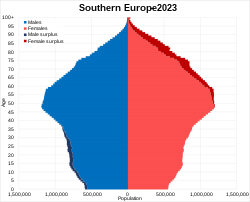
Languages
[edit]Romance languages
[edit]The most widely spoken family of languages in southern Europe are the Romance languages, the heirs of Latin, which have spread from the Italian peninsula, and are emblematic of Southwestern Europe (See the Latin Arch.). By far the most common Romance languages in southern Europe are Italian (spoken by over 50 million people in Italy, southern Switzerland, Malta, San Marino, and Vatican City) and Spanish, which is spoken by over 40 million people in Spain, Andorra and Gibraltar. Other common Romance languages include Portuguese (spoken in Portugal and Andorra), French (spoken in France, Monaco, and the Aosta Valley in Italy), Catalan (spoken in eastern Spain, Andorra, Southwestern France, and the Sardinian town of Alghero in Italy), Galician (spoken in northwestern Spain), Mirandese (spoken in northeast Portugal), and Occitan, which is spoken in the Val d'Aran in Catalonia, in the Occitan Valleys in Italy and in southern France.[citation needed]
Slavic languages
[edit]Slavic Languages are spoken in several countries on the Balkans. Bulgarian language (Български език) is spoken in Bulgaria (България). Bosnian-Serbian-Croatian is spoken in Kosovo, Croatia, Serbia, Bosnia, Montenegro, North Macedonia and Italy (in Molise). Slovenian is spoken in Slovenia, Italy (in Friuli-Venezia Giulia) and Croatia (in Istria) and Macedonian is spoken in North Macedonia.
Other languages
[edit]The Hellenic languages or Greek language are widely spoken in Greece and Cyprus. Additionally, other varieties of Greek are spoken in small communities in parts of other European countries.[citation needed]
English is used as a second language in parts of southern Europe. As a primary language, however, English has only a small presence in southern Europe, only in Gibraltar (alongside Spanish) and Malta (secondary to Maltese). English is also widely spoken in Cyprus.[citation needed]
There are other language groupings in southern Europe. Albanian is spoken in Albania, Kosovo, North Macedonia, Montenegro, Greece, Serbia, Croatia and Italy (particularly by the Arbëreshë people in southern Italy). Maltese is a Semitic language that is the official language of Malta, descended from Siculo-Arabic, but written in the Latin script with heavy Latin and Italian influences. The Basque language is spoken in the Basque Country, a region in northern Spain and southwestern France. Turkish is a Turkic language that is spoken in Turkey, Cyprus, Kosovo, Greece, North Macedonia and Bosnia, and German is spoken in Italy, particularly in South Tyrol.[citation needed]
Religion
[edit]The predominant religion in southern Europe is Christianity. Christianity spread throughout southern Europe during the Roman Empire, and Christianity was adopted as the official religion of the Roman Empire in the year 380 AD. Due to the historical break of the Church into the western half based in Rome and the eastern half based in Constantinople, different denominations of Christianity are prominent in different parts of Europe.[31] Christians in the western half of southern Europe — e.g., Portugal, Spain, Italy — are generally Roman Catholic. Christians in the eastern half of southern Europe — e.g., Greece, Serbia and North Macedonia — are generally Eastern Orthodox. Islam is widely practiced in Albania, Bosnia, Kosovo and Turkey and Northern Cyprus. Muslims are a significant minority in several countries of southern Europe- e.g., Greece, Italy, Spain.[32] Judaism was practiced widely throughout the European continent within the Roman Empire from the 2nd century.
Other classifications
[edit]CIA World Factbook
[edit]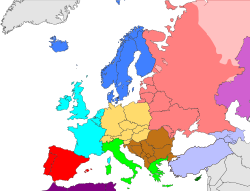
In the CIA World Factbook, the description of each country includes information about "Location" under the heading "Geography", where the country is classified into a region. The following countries are included in their classification "southern Europe":[33]
In addition, Andorra, Gibraltar, Portugal and Spain are classified as "Southwestern Europe", while Albania, Bosnia and Herzegovina, Bulgaria, Croatia, Montenegro, North Macedonia, Romania, Serbia and Turkey (the part west of the Bosporus) are described as located in "Southeastern Europe".
EuroVoc
[edit]
EuroVoc is a multilingual thesaurus maintained by the Publications Office of the European Union, giving definitions of terms for official use. In the definition of "southern Europe", the following countries are included:[34]
UN geoscheme classification
[edit]
The United Nations geoscheme is a system devised by the United Nations Statistics Division (UNSD) which divides the countries of the world into regional and subregional groups, based on the M49 coding classification. The partition is for statistical convenience and does not imply any assumption regarding political or other affiliation of countries or territories.[35]
In the UN geoscheme, the following countries are classified as southern Europe:[35]
- Albania
- Andorra
- Bosnia and Herzegovina
- Croatia
- Greece
- Holy See
- Italy
- Malta
- Montenegro
- North Macedonia
- Portugal
- San Marino
- Serbia
- Slovenia
- Spain
as well as the dependent territory:
European Travel Commission classification
[edit]European Travel Commission divides the European region on the basis of Tourism Decision Metrics (TDM) model. Countries which belong to the southern/Mediterranean Europe in this classification are:[36]
Albania, Bosnia and Herzegovina, Croatia, Greece, Italy, Malta, Montenegro, North Macedonia, Portugal, Serbia, Slovenia, Spain and Turkey.
See also
[edit]- Central and Eastern Europe
- Central Europe
- Eastern Europe
- EU Med Group
- EuroVoc#Southern Europe
- Mediterranean Basin
- Northern Europe
- Northwestern Europe
- Southeast Europe
- Western Europe
Notes
[edit]- ^ a b Often included. The United Nations geoscheme includes Bulgaria in Eastern Europe.
- ^ a b c Geographically a part of Asia, considered a European country in political geography.[2] The United Nations geoscheme includes Cyprus in Western Asia.
- ^ a b A British Overseas Territory.
- ^ a b Some Greek offshore islands near Asia Minor are considered parts of Asia in physical geography.
- ^ a b c Italy is part of Southwestern Europe. Most of Italy is on the Eurasian Plate, while some parts such as Apulia are on the Adriatic Plate. Pantelleria, the Pelagie Islands, and some parts of Sicily are located on the African Plate, near of the boundary between the African Plate and the Eurasian Plate.[2][3] The United Nations geoscheme includes Italy in southern Europe.
- ^ a b c In geology, the Maltese Islands is located on the African Plate.[2] The island group lies approx. 200 km south of the boundary between the African Plate and the Eurasian Plate.[3] In political geography, Malta is considered a European country. The United Nations geoscheme includes Malta in Southern Europe.
- ^ a b Sometimes included. The United Nations geoscheme includes Monaco in Western Europe.
- ^ Sometimes included, especially Alpes-Maritimes, Corsica, and Pyrénées-Orientales. The United Nations geoscheme includes Metropolitan France in Western Europe.
- ^ a b The European part of Turkey.
- ^ A part of Pyrénées-Orientales.
- ^ Sometimes included. French Cerdagne is the only part located on the Iberian Peninsula (Ebro Basin). The United Nations geoscheme includes Metropolitan France in Western Europe.
- ^ a b Sometimes included. The United Nations geoscheme includes Metropolitan France in Western Europe.
- ^ Sometimes included. Essentially on the south side of the Alps (Po Basin).[17][18] The United Nations geoscheme includes Switzerland in Western Europe.
- ^ Occasionally included. The United Nations geoscheme includes Moldova in Eastern Europe.
- ^ Sometimes included. The United Nations geoscheme includes Romania in Eastern Europe.
- ^ The highest mountain of Italy is Mont Blanc (4,810 m)
References
[edit]- ^ Southern Europe
- ^ a b c Taylor Combaluzier. "African & Arabian Tectonic Plates". McGill University, Montréal. Retrieved 18 June 2022.
- ^ a b Galea, Pauline (2007). "Seismic history of the Maltese Islands and considerations on seismic risk: Earthquakes in Malta". Annals of Geophysics. 50 (6): 725–740. Retrieved 5 June 2015.
- ^ Trudy Ring; Noelle Watson; Paul Schellinger (5 November 2013). Southern Europe: International Dictionary of Historic Places. Taylor & Francis. ISBN 978-1-134-25965-6.
- ^ José María Magone; Magone, José María Magone (2003). The Politics of Southern Europe: Integration Into the European Union. Greenwood Publishing Group. pp. 292–. ISBN 978-0-275-97787-0.
- ^ Europe, Southern: Italy, Cyprus, Greece, European Turkey: Selected References. Air University Library. 1992.
- ^ Encyclopedia of Social and Cultural Anthropology, Alan Barnard and Jonathan Spence. Retrieved 10 October 2015.
- ^ UCF Libraries – Southern Europe
- ^ Which Countries Make Up Southern Europe? WorldAtlas
- ^ "Global Forest Resources Assessment 2000 - Chapter 30. Southern Europe". Food and Agriculture Organization of the United Nations. 2000. Retrieved 26 November 2021.
- ^ Romania | History, Map, & Facts | Britannica
- ^ Robert E. Dickinson (1969). The Makers of Modern Geography. Routledge Library Editions: Social and Cultural Geography. p. 16. ISBN 9781317907336.
He (August Zeune) divided Europe into its major divisions. Southern Europe falls into three units — the Pyrenean, Alpine, and Balkan peninsulas.
- ^ "Europe: Physical Geography". National Geographic Society. 4 January 2012. Retrieved 21 February 2022.
Europe's main peninsulas are the Iberian, Italian, and Balkan, located in southern Europe
- ^ "Mediterranean sea-surface temperature". ESA. 2012. Retrieved 19 November 2021.
- ^ Barale, Vittorio (January 2011). "Fig. 3.a: Sea surface temperature of the Mediterranean Sea (water masses and physical processes)". The coastal dimension of maritime spatial planning. ResearchGate. Archived from the original on 23 April 2023. Retrieved 4 September 2021.
- ^ "2010-2019 SST in the Mediterranean". eo science for society. 24 June 2019. Retrieved 19 November 2021.
- ^ James Redfern (1971). A Lexical Study of Raeto-Romance and Contiguous Italian Dialect Areas. Mouton Publishers. p. 38. ISBN 9783110824841.
The canton of the Ticino marks the geographic descent from high Alps to plain and is, therefore, a land of climatic as well as linguistic transition, where heat and abundant moisture favor almonds, figs, and all the fruits common to southern Europe, except the olive.
- ^ OECD (2002). OECD Territorial Reviews: Switzerland 2002. OECD Publishing. p. 80. ISBN 9789264160651.
The Regio Insubrica spreads over three Italian provinces (Verbano-Cusio Ossola, Varese, Como) and the Swiss canton of Ticino. The national border cuts across a culturally and geographically homogenous territory. The region is peripheral for both countries, but it is an essential pole of communication between Northern and Southern Europe.
- ^ "Mediterranean Basin". Critical Ecosystem Partnership Fund. Retrieved 31 December 2020.
- ^ Wolfgang Frey and Rainer Lösch; Lehrbuch der Geobotanik. Pflanze und Vegetation in Raum und Zeit. Spektrum Akademischer Verlag, München 2004
- ^ Stefano Mazzoleni (2004). Recent Dynamics of the Mediterranean Vegetation and Landscape. John Wiley & Sons. p. 145.
In the coastal areas, the olive groves are tightly interwoven with low maquis, garrigue and steppe, which have been widely grazed and, consequently, burned. On the other hand, low mountains and inland hills have chestnut and mixed deciduous coppiced woods. The actual boundaries between these two different vegetation landscapes can be found at different altitudes according to local climatic conditions; higher (about 1000m asl) in the eastern and southern areas, and lower and close to the sea in the central and northern basin.
- ^ "Phoenicia". World History Encyclopedia. Retrieved 9 August 2017.
- ^ e.g. Averroes#Commentaries on Aristotle written in the 12th century, which was mentioned in Divine Comedy IV:144 Archived 2015-06-20 at the Wayback Machine around 1320 AD
- ^ Truxillo, Charles A. By the Sword and the Cross: The Historical Evolution of the Catholic World Monarchy in Spain and the New World, 1492-1825.
- ^ Richard J. Mayne. "history of Europe:: The Middle Ages". Britannica Online Encyclopedia. Retrieved 18 April 2009.
- ^ Steven Kreis (11 October 2006). "The Origins of the Industrial Revolution in England". Historyguide.org. Retrieved 31 January 2010.
- ^ Vértesy, László (2018). "Macroeconomic Legal Trends in the EU11 Countries" (PDF). Public Governance, Administration and Finances Law Review. 3. No. 1. 2018.
- ^ "From 6 to 27 members". ec.europa.eu. 6 December 2016. Retrieved 15 March 2021.
- ^ Sarah Baxter (2017). History of the World in 500 Railway Journeys. The Quarto Group. p. 357. ISBN 9781781319383.
The first Gotthard Tunnel, a 9-mile (14 km) engineering marvel of its time, was dug between 1872 and 1882; 199 men died in the process. Running between the Swiss villages of Göschenen and Airolo, it was the first modern railway link between northern and southern Europe, and it is still used today.
- ^ World Bank (2018). The WEB of Transport Corridors in South Asia. p. 186. ISBN 9781464812163.
The Rhine-Alpine Corridor is a north-south corridor extending from the North Sea ports of Rotterdam and Antwerp to the Mediterranean port of Genoa in northern Italy. The corridor is a primary artery for transporting goods in Europe.
- ^ Chazan, Robert (2006). The Jews of Medieval Western Christendom: 1000-1500. Cambridge: Cambridge University Press. p. xi. ISBN 9780521616645. Retrieved 26 January 2018.
- ^ Conrad Hackett (29 November 2017), "5 facts about the Muslim population in Europe", Pew Research Center, archived from the original on 21 April 2023
- ^ CIA. "The World Factbook". Archived from the original on 24 January 2024.
- ^ Publications Office of the European Union. "7206 Europe". EU Vocabularies. Archived from the original on 6 March 2020.
- ^ a b "Methodology". UNSD. Retrieved 17 June 2019.
- ^ Tourism Economics (July 2014). "European Tourism 2014 – Trends & Prospects - Quarterly Report (Q2/2014)" (PDF). European Travel Commission. p. 5. Archived (PDF) from the original on 23 April 2023.











